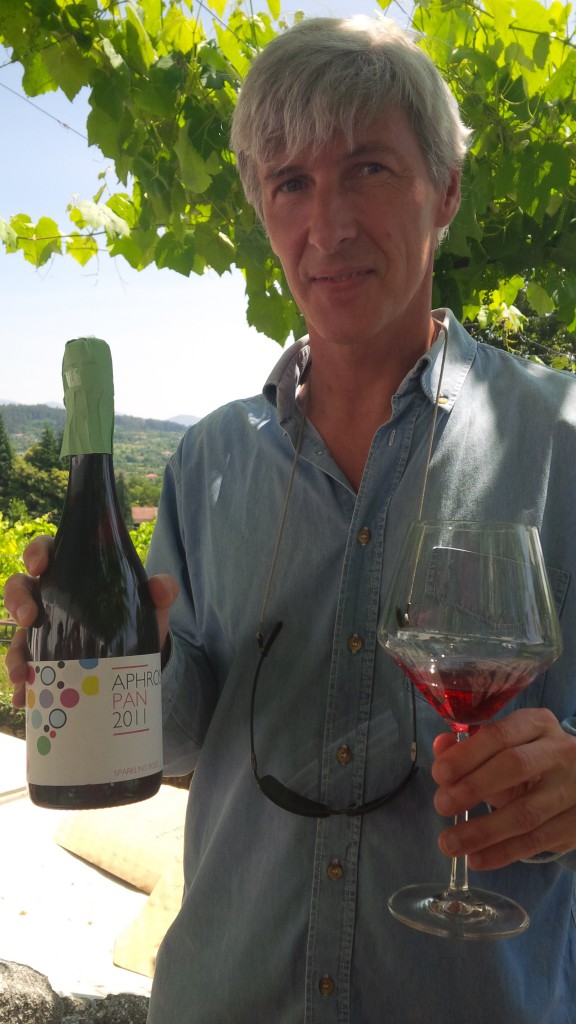
Sometimes in our lives we are fortunate to make something without there having to be a reason, a single thought that leads inexorably to action. Rather, as in every phenomenon in Nature, there seems to be an interconnectedness of multiple factors, supporting the processes of thinking and feeling and doing.
Such was the case with our amphora project. Initially, we were awed by this archetypal, most ancestral method of making wine, one which spoke strongly to our souls. Our ancestors worked with intuition, as if they were at one with their environment. They did not strain to find the most clever and technical way to produce something, nor did they practice trial and error methods, or waste unnecessary energy and resources. Everything they did was in harmony with both with their inner life and the workings of the outside world. Indeed such a line of division probably did not exist for them.
Wine, as originating in the Caucasus some 8,000 years ago, was more than a mere beverage. I believe people were inspired to experience it as part of their own life path, using it for the religious rituals that celebrated and revealed their being unto themselves. The forms of religious experience developed with evolving cultures in the Mediterranean, assuming new forms in time – Egyptian, Hebrew, Greek, Roman and Christian – always keeping the clay amphora as the vessel for the magical transformation of what really can be considered the xamanic substance of the West.
In recent years I have been fortunate to taste amphora wines from different parts of the world. They occupy a unique space in the wine world, not just because of the marked difference in taste and texture of the wines, but in the very sense of their vitality and completeness. Drinking Pheasant’s Tear’s wines, for instance, evokes the legend of the bird that cried tears of joy (there is a Georgian saying that “only the finest wines can compel the pheasant to cry tears of joy”) and elicit that same reaction, that sense of epiphany, within me. This has certainly to do with quality of grapes and the producers who look after their special terroir, but also with the process itself, including the discernible effect of form upon substance and the way in which the ovoid shape of the clay vessel induces a subtle circulation of electromagnetic fields within the liquid, as evinced by the research of Victor Schauberger, a pioneer in the quantum physical study of Nature’s subtle energies.

Moreover, amphorae are lined with beeswax, a substance that carries the memory of the hive from which it originates. It protects and informs the wine (or any other substance inside an amphora) with its singular energies. According to Steiner, life inside a beehive is the most elevated we can find in Nature, presenting an image of a society that humans may only achieve in the far distant future.
As the desire to make amphora wines intensified, the actual possibility for making them arose this year when we completed a new winery for the Aphros classic range of wines. At this point the old cellar space in the basement of our XVII century house was finally liberated from all the modern equipment (inbox vats, temperature control etc) it had to endure for many years. Indeed, the inappropriateness of this equipment for the space had been hurting my heart and filling it with the desire to go in another direction – to create a silent, almost monastic cellar, without technology and electricity, which I like to call the medieval cellar. Which is now ready and functioning, with nine amphorae that have just been filled with wine.
It is hard to credit what a natural and effortless endeavour it was to make this conversion. The amphorae (which are very difficult to find) that found their way to me were from Alentejo, all six from the same supplier, lined with beeswax by a marvellous potter (who is also a healer and is conversant with plant medicine). In the cellar, all I had to do was to remove a lot of electric cables, build a 20 cm step for the amphorae, and change the lighting. As for equipment I bought a perfectly functioning manual pump for 180,00 euros, had a manual de-stemmer made by a carpenter, and recycled a crusher and a press from my great grandmother’s time.
We’re making two different wines: a 100% Loureiro, which is now fermenting in three amphorae, each with a different proportion of stems/whole grapes/must; and a Palhete, a blend of 80% Loureiro and 20% Vinhão.
The Palhete is in line with the tradition of ancient Portuguese wines. Most red wines in Iberia were in fact blends of white and red grapes before the XVIII century. That is why they were called Tinto, meaning tinted. In medieval times the symbolic image that monks had in mind, when making red wine, was the blood of Christ. A wine that to contain light and transparency within itself. In Alentejo, the Portuguese region where the amphora tradition has been established for 2000 years, white wines (from amphora) are the most typical and appreciated, but they also produce palhete, blending white and red grapes, which they call petroleiro (petroleum boat) because of the similarity of the colour.

